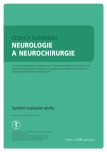Pulmonary management of spinal muscular atrophy
Authors:
T. Doušová 1; J. Plešková 2; A. Chmelařová 2
Authors‘ workplace:
Pediatrická klinika 2. LF UK a FN Motol
1; Klinika rehabilitace a tělovýchovného lékařství 2. LF UK a FN Motol
2
Published in:
Cesk Slov Neurol N 2020; 83/116(Supplementum 2): 35-40
doi:
https://doi.org/10.48095/cccsnn20202S35
Overview
Spinal muscular atrophy (SMA) has an impact on respiratory complications that are dependent on the severity of the loss of muscle function. Individuals with SMA type I or II typically develop respiratory muscle weakness, with progressive respiratory failure in most severe forms. Ineffective cough is a result of inspiratory and more expiratory muscle weakness and contributes to repeated respiratory infections. In some patients, gradual progression results in sleep-disordered breathing. Over the last decade, there has been increasing evidence of improvements in the natural history of all the SMA types. Even in the most severe form, there has been an increase insurvival and quality of life as a result of a more proactive approach, following the introduction of non-invasive ventilation and cough assist devices. The approval of the first drug for SMA in December 2016 and promising early results from other clinical trials have changed the perspective of physicians and families dramatically, especially in SMA type I. The mainstay of care is amultidisciplinary team, where a pneumologist and a respiratory physiotherapist play an important role. The variability in clinical care between medical centers has resulted in Consensus Statement for Standards of Care. Here we present a modified version of these standards.
Sources
1. Kolb SJ, Kissel JT. Spinal muscular atrophy: a timely review. Arch Neurol 2011; 68(8): 979–984. doi: 10.1001/ archneurol.2011.74.
2. Finkel RS, Chiriboga CA, Vajsar J et al. Treatment of infantile-onset spinal muscular atrophy with nusinersen: a phase 2, open-label, dose-escalation study. Lancet 2016; 388(10063): 3017–3026. doi: 10.1016/ S0140-6736(16)31408-8.
3. Finkel RS, Mercuri E, Meyer OH et al. Diagnosis and management of spinal muscular atrophy: Part 2: Pulmonary and acute care; medications, supplements and immunizations; other organ systems; and ethics. Neuromuscul Disord 2018; 28(3): 197–207. doi: 10.1016/ j.nmd.2017.11.004.
4. Hull J. British Thoracic Society guideline for respiratory management of children with neuromuscular weakness: commentary. Thorax 2012; 67(7): 654–655. doi: 10.1136/ thoraxjnl-2012-202043.
5. Bach JR, Baird JS, Plosky D et al. Spinal muscular atrophy type 1: Management and outcomes. Pediatr Pulmonol 2002; 34(1): 16–22. doi: 10.1002/ ppul.10110.
6. Caruso P, Albuquerque AL, Santana PV et al. Diagnostic methods to assess inspiratory and expiratory muscle strength. J Bras Pneumol 2015; 41(2): 110–123. doi: 10.1590/ s1806-37132015000004474.
7. Abusamra R, Ross Russell R. Management of respiratory disease in children with muscular weakness. Paediatr Child Heal (United Kingdom) 2015; 25(11): 515–521. doi: 10.1016/ j.paed.2015.06.011.
8. Neumannová K, Doušová T, Sedlák V et al. Dopo-ručený postup České pneumologické a ftizeologickéspolečnosti a České společnosti dětské pneumologie pro dlouhodobou domácí léčbu poruch expektorace pomocí přístroje CoughAssist. Cesk a Slov Neurol N 2017; 80/ 113(4): 480–484. doi: 10.14735/ amcsnn2017480.
9. Schroth MK. Special considerations in the respiratory management of spinal muscular atrophy. Pediatrics 2009; 123 (Suppl 4): S245–S249. doi: 10.1542/ peds.2008-2952K.
10. Petrone A, Pavone M, Testa MB et al. Noninvasive ventilation in children with spinal muscular atrophy types 1 and 2. Am J Phys Med Rehabil 2007; 86(3): 216–221. doi: 10.1097/ PHM.0b013e31802ef774.
11. Ward S, Chatwin M, Heather S et al. Randomised controlled trial of non-invasive ventilation (NIV) for nocturnal hypoventilation in neuromuscular and chest wall disease patients with daytime normocapnia. Thorax 2005; 60(12): 1019–1024. doi: 10.1136/ thx.2004.037424.
12. Bach JR, Bianchi C. Prevention of pectus excavatum for children with spinal muscular atrophy type 1. Am J Phys Med Rehabil 2003; 82(10): 815–819. doi: 10.1097/ 01.PHM.0000083669.22483.04.
Labels
Paediatric neurology Neurosurgery NeurologyArticle was published in
Czech and Slovak Neurology and Neurosurgery

2020 Issue Supplementum 2
- Metamizole vs. Tramadol in Postoperative Analgesia
- Memantine in Dementia Therapy – Current Findings and Possible Future Applications
- Memantine Eases Daily Life for Patients and Caregivers
- Metamizole at a Glance and in Practice – Effective Non-Opioid Analgesic for All Ages
- Advances in the Treatment of Myasthenia Gravis on the Horizon
Most read in this issue
- Clinical manifestations of spinal muscular atrophy in adult patients
- Genetics of spinal muscular atrophy
- Therapy of spinal muscular atrophy
- Rehabilitation in spinal muscular atrophy
